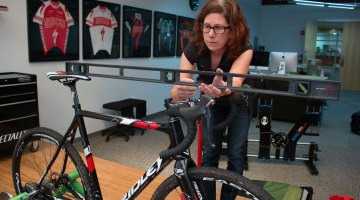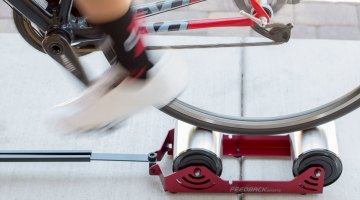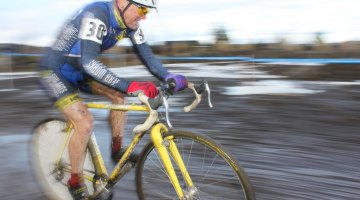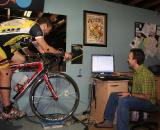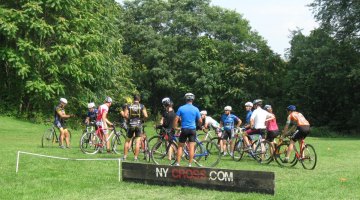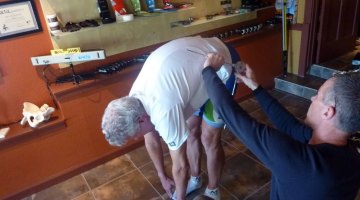by Molly Hurford
Ask any cyclist about bike fits and there will be a different response. As one pro racer uttered under his breath when we started talking about bike fit over dinner in a group last month, “Everyone is an expert.” We’ve talked about bike fit a bit over the years, but it’s always been a murky area where everyone has an opinion and two opinions are rarely the same.
Still, I’ve had good experiences with fitting for my road bike in the past, but hadn’t been fit on a cyclocross bike or a mountain bike before. I wanted to see what an actual expert would do for my bike fit, so I turned to Eddie O’Dea, a Wobble-Naught specialist and co-owner of 55nine Performance. He’s also behind races including Southern Cross and Fool’s Gold, and an awesome endurance MTB racer in his own right. I brought in my cyclocross bike and my mountain bike, with the intent of seeing what the differences in fit, if both bikes were fit at the same time and by the same person, would be. It turns out, a proper MTB fit isn’t the same as a proper cyclocross fit, and O’Dea walked me through the key differences while helping me find the right balance (pun intended) on both bikes.
Wobble-Naught isn’t the only fit method out there, but it is one of the few that has a different formula for fitting mountain bikes compared to road and cyclocross bikes, so I was intrigued by that. Their tagline is “Quantitative Scientific Comfort,” and considering the use of virtually every skeletal measurement under the sun (at one point, O’Dea traced my feet!) as well as the use of lasers and video to show how the angles on the bike worked before and after, scientific comfort is an accurate statement. There are so many other fit methods out there, and so many how-to websites and articles, but for someone who’s spent a lot of years not feeling quite right on a bike, I still prefer going to someone who knows a bit more about fit than I do, and who can answer questions I have (like, “Does it matter that one leg is a teensy bit longer than the other?”).
For my custom steel NFG ’cross bike, we had a lot to work with. Built for me, the top tube is sloped to make for easier and more efficient suitcasing, but it leaves me with a feeling of being too high above the ground. While I’d been briefly fit on the bike before and liked it, I knew there was room for improvement, so O’Dea was eager to help and offer suggestions for more efficient handling. I waste a lot of energy with my upper body on both my ‘cross bike and my MTB, O’Dea told me after observing my normal riding stances, and he wanted to work to fix that. A good portion of our time was spent with him using skeletons and showing me what I was doing to my body and how I could fix it, and I left the fit not just knowing how I should be sitting on the bike, but why I should be sitting that way.
“To start with, we took a series of skeletal measurements of the individual and the geometry measurements of the bike,” O’Dea explains, “And I used the W-N’s software to get cleat placement, saddle placement measurements and the reach out to the bars. Ultimately, we want a setback post on this bike [common on small frames for both fit and avoiding toe overlap].”
What we were looking for was, as O’Dea explained, “That Molly will be able to stay in the middle of her range of motion throughout her pedal stroke, and have a neutral spine … What that really means is she can get power from all of those positions – for climbing, for the flats, for sprinting – and not have to sacrifice comfort to get that level.” Putting out power without hurting oneself is the goal.
Fitting a cyclocross bike isn’t the same as a road bike, since there are different goals in mind. “For ’cross, we’re looking to maximize the acceleration from low speed up to mid-speed. You’re not looking at a lot of time spent over 20 MPH, it’s that ability to go from zero cadence out of a turn up to whatever your high end is, so we want to maximize the ability to turn over the legs fast.”
O’Dea continues, “The other thing we need is really sharp handling. You don’t want to have too much or too little weight on the front end, so that balance is really important for the ’cross bike.”
And there’s also obviously a difference between a cyclocross bike fit and mountain bike fit. “The mountain bike solution is a little more forward and a little bit taller and what that does is get you a bit more leg extension, get you a bit more over the top of the bottom bracket, specifically for the steeper climbs, since that’s where the difference is made in cross country mountain biking.”
“The contact points are set up so you can achieve higher torque.”
One of the big points that O’Dea focused in on was my pedal stroke. In the course of the fit, he didn’t just take measurements and make adjustments, he started to retrain how I pedal to maximize efficiency. I can safely say after two months of riding on the bikes that he fit and focusing on his advice, I understand why he wanted my pedal stroke to improve! “It’s not just about setting up the bike, it’s about teaching the individual better pedal styles and learning their own best pedal styles, learning their range of motion and how to operate within it. It’s so you can get more torque and more power, but less wear and tear on your body.”
Even if you can’t get a bike fit and spend time working on a pedal stroke or fit, O’Dea has some quick tips. “It’s not really heel down, it’s not toe down, it’s in the middle of those two. The same thing with hip angle and your spine: it’s not about being at one end of the range of motion or another, it’s about working from the middle.”
After two months riding both my freshly fit cyclocross bike and mountain bike, I’ve noticed a lot of improvements. My pedal stroke, as I said, has improved considerably, especially when I’m actually thinking about it while I ride. On my mountain bike, we chopped the bars and changed out the stem (longer) and raised the seat a bit, and with that came a whole new world of riding for me. My bars, previously un-chopped, were almost four inches shorter at the end of the fit session, and the way the bike handles changed entirely, for the better. Between that and the new position, I’m a lot more capable in turns and, as O’Dea pointed out, on steep hills (see my last column to that effect here!). As for the cyclocross bike, it’s been a gravel machine ever since it got fit. I took it to the Barry Roubaix as its first test, and it definitely felt racy-er and more aggressive than it did all season.
Check out more of what O’Dea had to say here:
We’ll be looking at fit more in the future, as we explore the other methods of fitting, so stay tuned.
























